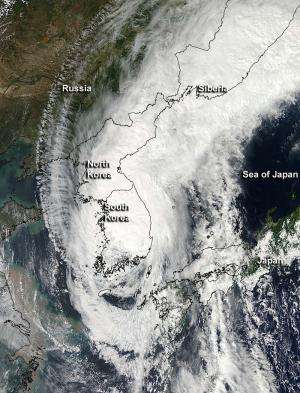NASA sees powerful Typhoon Sanba make landfall

Typhoon Sanba made landfall in southern South Korea on Monday, Sept. 17 and was moving northeast bringing heavy rainfall, and gusty winds along its path. Sanba downed trees, and caused power outages, canceled flights and canceled ferries. NASA's Aqua satellite captured a visible image of Sanba on Sept. 17 after it made landfall and observed the large extent of its cloud cover from South Korea to eastern Siberia.
NASA's Aqua satellite passed over Tropical Storm Sanba on Sept. 17 at 0430 UTC (12:30 a.m. EDT/1:30 p.m. local time Seoul, South Korea) and the Moderate Resolution Imaging Spectroradiometer (MODIS) instrument captured this visible image of the storm when it was over South and North Korea. The image revealed that some of Sanba's clouds extended north over northeastern North Korea and eastern Siberia.
According to the Associated Press, Sanba caused about 67,000 homes to lose power in southern Japan, and over 26,000 outages in South Korea. At least one death was reported.
At 0900 UTC (5 a.m. EDT) on Sept. 17, Sanba had maximum sustained winds near 45 knots (52 mph/83 kmh). It was located about 10 nautical miles northwest of Taegu, South Korea, near 37.2 North and 128.9 East. Since making landfall earlier in the day the storm has sped up and is moving to the north-northeast at 20 knots (23 mph/37 kmh). Surface observations from Taegu at that time indicated maximum sustained winds near 24 knots (27.6 mph/44.4 kmh) with gusts to 40 knots (46 mph/74 kmh).
Sanba is expected to experience some big changes over the next day. It is tracking over the rough terrain of the Taebaek Mountain range and is transitioning into an extra-tropical storm. That means that the core of the system will change from warm to cold.
The Joint Typhoon Warning Center expects Sanba to become a cold core low after its remnants emerge back in the Sea of Japan later today, Sept. 17, if it doesn't dissipate over land.
Provided by NASA's Goddard Space Flight Center





















